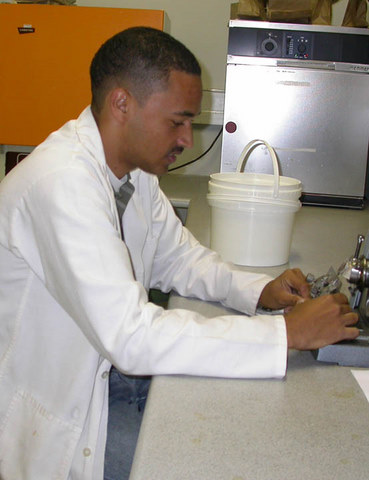
Contact
Room 05-058, Biological and Conservation
Science Building, Westville Campus
Tel: +27 31 2608657
Fax: +27 31 2601195
E-mail: 202518472@stu.ukzn.ac.za
Research title: The embryogeny, post-shedding seed behaviour and the development of biotechnological strategies for the cryopreservation of Encephalartos natalensis (Zamiaceae) germplasm
Project description:
A range of microscopical techniques are being used to gain insight into the in ovulo embryogeny of E. natalensis from seed-shed to maturity. Light microscopy is being employed to follow the overall development of the embryo at the tissue level of organisation. The deposition of lipid, protein and carbohydrate reserves in the embryo is being investigated using histochemical. In parallel with the histochemical study, the accumulation of the aforementioned reserves will be analysed more closely (i.e. categorised and quantified) biochemically. Previous work by this student focused on the ontogeny of the megagametophyte, which functions as the nutrient reserve tissue of the seed for the growth and development of the embryo. Therefore, the post-shedding embryogeny of E. natalensis will be compared and contrasted with the ontogeny of the megagametophyte. Of particular interest is the cellularisation of the embryo proper. The student’s work on the megagametophyte showed an unusual mode of primary cell wall deposition that appeared to preclude involvement of the Golgi body (Woodenberg et al., 2010). The ultrastructural development and initial cellularisation of the E. natalensis embryo will thus be investigated closely using TEM of conventionally-prepared and freeze substituted material and Immunocytochemistry, to determine whether or not a similar mode of deposition occurs.
Previous work by the student showed that seeds of the current species do not fall into the orthodox category and thus cannot be stored in ex situ collections in the long-term (i.e. many years). Arguably the best method for long-term conservation of species producing non-orthodox seeds is the cryopreservation of embryonic axes; however, cycads produce seeds with axes far too large for cryopreservation. Therefore, the Ph.D. work focuses on the development of protocols for the cryopreservation of alternative sources of cycad explants, starting with E. natalensis. Envisaged explants are adventitious shoots and/or meristems. Since this species sheds seed at a relatively early stage of embryogeny, cryopreservation of the small, underdeveloped embryos characteristic of newly-shed cycad seeds is also being explored, on the basis that their on-going in vitro development and germination could be effected.
Since cycads occupy an important evolutionary position, the research is also incorporating micro-array analyses to determine whether or not genes conferring desiccation tolerance in the angiosperm, Xerophyta humilis, are present in the genome of the desiccation-sensitive E. natalensis embryo. We wish to establish whether the genes are present in the genome but not expressed during embryological development, or absent entirely. Cross-species genome hybridisation will be performed using genomic DNA of the E. natalensis embryo as a probe against the target sets of desiccation-associated genes from X. humilis.
It is expected that the research work comprising this Ph.D. study will shed new light on cycad seed biology and plant evolution, and make way for the successful commercial production and germplasm cryopreservation of these fascinating, yet endangered, plants.
Publications
WOODENBERG, W.R., BERJAK, P. and PAMMENTER, N.W. (2010). Development of cycad ovules and seeds. 1. Implication of the ER in primary cellularisation of the megagametophyte in Encephalartos natalensis Dyer and Verdoorn. Plant Growth Regulation SI Plant Desiccation 62, 265-278. [ISSN: 0167-6903 (Print) 1573-5087 (Online) DOI: 10.1007/s10725-010-9469-6 Published online: 10 April 2010]